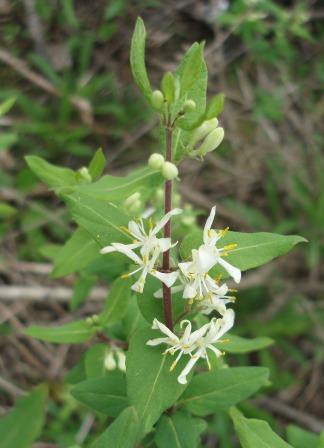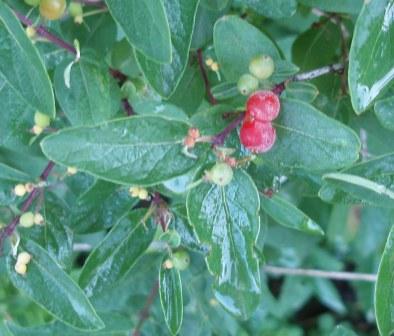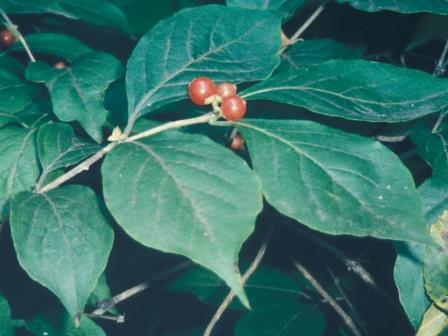by Carl Strang
Invasive bush honeysuckles are one of the main challenges in woodland restoration in northeast Illinois. Managing them doesn’t really require distinguishing the varieties, but in my preserve monitoring at Mayslake I feel I should have a handle on what is there. My old understanding was that there are two main forms, the Amur honeysuckle and the Tartarian honeysuckle. Over the winter I became aware that the botany is more complicated than that, and this spring I have done my best to sort it out. To keep things clear, in this post I will include scientific names in the main text rather than just in the tags at the top. Amur honeysuckle (Lonicera maackii) proves to be uncomplicated. The leaves are relatively big, and have drawn out or attenuated tips.
The most common of the varieties I once referred to as “Tartarian honeysuckle” in fact is a hybrid, Lonicera X muendeniensis, the common fly honeysuckle.

Common fly honeysuckle, showing its white flowers. These turn yellow after a while, which would not happen in Tartarian honeysuckle.
Another hybrid, practically identical to the common fly honeysuckle except that the flowers are pink (but which likewise turn yellow in time), is the showy fly honeysuckle (Lonicera X bella). At Mayslake these are relatively few, and seem randomly scattered among the others.

This photo of one of the fly honeysuckles gives a good idea of the leaf shape, smaller and blunter than in Amur honeysuckle.
Having gotten this far, I ran into a few honeysuckles along Mayslake Forest Preserve’s 31st Street boundary that were distinctly different. These keyed to another species, Morrow’s honeysuckle (Lonicera morrowii).

The leaves are much larger and rounder than those of the fly honeysuckles, and the flowers are a little smaller.
All of this terminology is based on the most recent addition of the Swink & Wilhelm reference, Plants of the Chicago Region. Errors in identification are, of course, mine.
